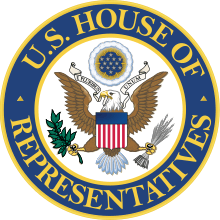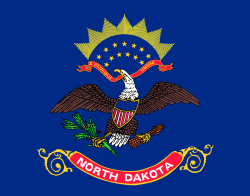William Lemke
William Frederick Lemke (August 13, 1878 – May 30, 1950) was a United States politician. He represented North Dakota in the United States House of Representatives as a member of the Republican Party. He was also the Union Party's presidential candidate in the 1936 presidential election.
William Lemke | |
|---|---|
.jpg) | |
| Member of the U.S. House of Representatives from North Dakota's at-large district | |
| In office January 3, 1943 – May 30, 1950 | |
| Preceded by | Charles R. Robertson |
| Succeeded by | Fred G. Aandahl |
| In office March 4, 1933 – January 3, 1941 | |
| Preceded by | Olger B. Burtness |
| Succeeded by | Charles R. Robertson |
| 11th Attorney General of North Dakota | |
| In office 1921–1922 | |
| Governor | Lynn Frazier Ragnvald Nestos |
| Preceded by | William Langer |
| Succeeded by | Sveinbjorn Johnson |
| Personal details | |
| Born | William Frederick Lemke August 13, 1878 Albany, Minnesota, U.S. |
| Died | May 30, 1950 (aged 71) Fargo, North Dakota, U.S. |
| Political party | Republican Union (1935–1936) Progressive (1912) |
| Other political affiliations | Nonpartisan League |
| Spouse(s) | Isabelle McIntyre |
| Children | 3 |
| Education | University of North Dakota (BA) Georgetown University Yale University (LLB) |
Life and career
He was born in Albany, Minnesota, and raised in Towner County, North Dakota, the son of Fred Lemke and Julia Anna Kleir, pioneer farmers who had accumulated some 2,700 acres (11 km2) of land. As a boy, Lemke worked long hours on the family farm, attending a common school for only three months in the summers. However, the family did reserve enough money to send him to the University of North Dakota, where he was not only a superior student, but also well known for his ability to impersonate the professors. Graduating in 1902, he stayed at the state university for the first year of law school but moved to Georgetown University, then to Yale Law School, where he finished work on his law degree and won the praise of the dean. He returned to his home state in 1905 to set up practice at Fargo. Lemke was a Freemason.
Lemke was the attorney general of North Dakota from 1921 to 1922. He later was elected to the United States House of Representatives in 1932, an NPLer. He served four two-year terms in Congress.
While in Congress, Lemke earned a reputation as a progressive populist and supporter of the New Deal, championing the causes of family farmers and co-sponsoring legislation to protect farmers against foreclosures during the Great Depression.
In 1934, Lemke co-sponsored the Frazier–Lemke Farm Bankruptcy Act, restricting the ability of banks to repossess farms. President Franklin D. Roosevelt signed the act into law on June 28, 1934. The Act was later ruled unconstitutional by the Supreme Court in Louisville Joint Stock Land Bank v. Radford. Lemke tried to get the Act re-passed by Congress, but was stymied by the Roosevelt administration which privately told Congressmen that they would exercise a Presidential veto against the bill. The Act was eventually re-passed and later held constitutional by the Supreme Court. Lemke was a political friend and ally of Louisiana populist Huey Long prior to his assassination in 1935.
Later in 1936, Lemke accepted the nomination of the Union Party, a short-lived third party, as its candidate for President of the United States.[1] He received 892,378 votes, or just under two percent nationwide, and no electoral votes in the 1936 election. Lemke did outpoll Alf Landon in five North Dakota counties[2][lower-alpha 1] and remained the last third-party presidential candidate to outpoll a major-party nominee in any non-southern county[lower-alpha 2] until George Wallace outpolled Hubert Humphrey in Utah's arch-Republican Kane County in 1968 and his successor John G. Schmitz outpolled George McGovern in four Idaho counties in 1972.[3] Simultaneously, he was reelected to the House of Representatives as a Republican. Many believe Lemke's acceptance of the Union Party nomination in 1936 was out of bitterness toward Roosevelt over the farm mortgage issue. Through the Union Party, Lemke befriended other populists such as Fr. Charles Coughlin.
In 1940, after having already received the Republican nomination for a fifth House term, he withdrew from that race to launch an unsuccessful run as an independent for the U.S. Senate. He ran again for Congress in 1942 as a Republican and served four more terms, until his death in 1950.
From 1943 to 1948, Lemke was the champion for establishment of the Theodore Roosevelt National Memorial Park (now Theodore Roosevelt National Park). The National Park Service did not support this proposal, and oddly enough Lemke was no admirer of Theodore Roosevelt, but he seems to have pursued the establishment of a park in anticipation of the economic benefits it might bring to the region. His efforts were ultimately successful, with the park established by act of Congress in June, 1948 [4].
Lemke died of a heart attack in Fargo, North Dakota and is buried in Riverside Cemetery.[5][6] Former Atlanta Braves baseball player Mark Lemke is Lemke's second cousin twice removed.
Bibliography
- Edward C. Blackorby. "William Lemke: Agrarian Radical and Union Party Presidential Candidate," The Mississippi Valley Historical Review, Vol. 49, No. 1. (Jun., 1962), pp. 67–84. in JSTOR
- William Lemke Papers at The University of North Dakota University of North Dakota.
- "Lemke, William" in American National Biography. American Council of Learned Societies, 2000.
See also
- List of United States Congress members who died in office (1950–99)
References
- Lubell, Samuel (1956). The Future of American Politics (2nd ed.). Anchor Press. pp. 151–152. OL 6193934M.
- Scammon, Richard M. (compiler); America at the Polls: A Handbook of Presidential Election Statistics 1920-1964; pp. 339, 343 ISBN 0405077114
- Menendez, Albert J.; The Geography of Presidential Elections in the United States, 1868-2004, p. 100 ISBN 0786422173
- Harmon, David (1986). "The Creation of the Park". At the Open Margin: The NPS's Administration of Theodore Roosevelt National Park. Theodore Roosevelt Nature and History Association.
- United Press (May 31, 1950). "William Lemke, 71, Congressman, Dies. North Dakota Republican Was Candidate for President on Union Party Slate in '36". New York Times. Retrieved 2015-01-14.
Representative William Lemke, Republican of North Dakota, died on the way to a hospital tonight soon after he collapsed in the Power Hotel in downtown Fargo. He was 71 years old.
- "Lemke, House Veteran, Dies of Heart Attack" (PDF). Binghamton Press. May 31, 1950.
Notes
- These five were Burke County, Divide County, Mountrail County, Towner County and Williams County.
- During this era, the political impact of Civil Rights Movement meant unpledged and "Dixiecrat" nominees frequently outpolled one or both major-party nominees in the Deep South and occasionally elsewhere in antebellum slave states.
External links
| Wikimedia Commons has media related to William Lemke. |
- United States Congress. "William Lemke (id: L000238)". Biographical Directory of the United States Congress.
- Dakota Datebook -- August 13, 2004 from North Dakota Public Radio (via PrairiePublic.org) -- article on Lemke
- "Memorial services held in the House of Representatives of the United States, together with remarks presented in eulogy of William Lemke, late a representative from North Dakota frontispiece 1951"
| Legal offices | ||
|---|---|---|
| Preceded by William Langer |
Attorney General of North Dakota 1921–1922 |
Succeeded by Sveinbjorn Johnson |
| U.S. House of Representatives | ||
| Preceded by Olger B. Burtness |
Member of the U.S. House of Representatives from North Dakota's at-large congressional district 1933–1941 |
Succeeded by Charles R. Robertson |
| Preceded by Charles R. Robertson |
Member of the U.S. House of Representatives from North Dakota's at-large congressional district 1943–1950 |
Succeeded by Fred G. Aandahl |
| Party political offices | ||
| Preceded by Lynn Frazier |
Nonpartisan League nominee for Governor of North Dakota 1922 |
Vacant Title next held by William Langer |
| New political party | Union nominee for President of the United States 1936 |
Party dissolved |

